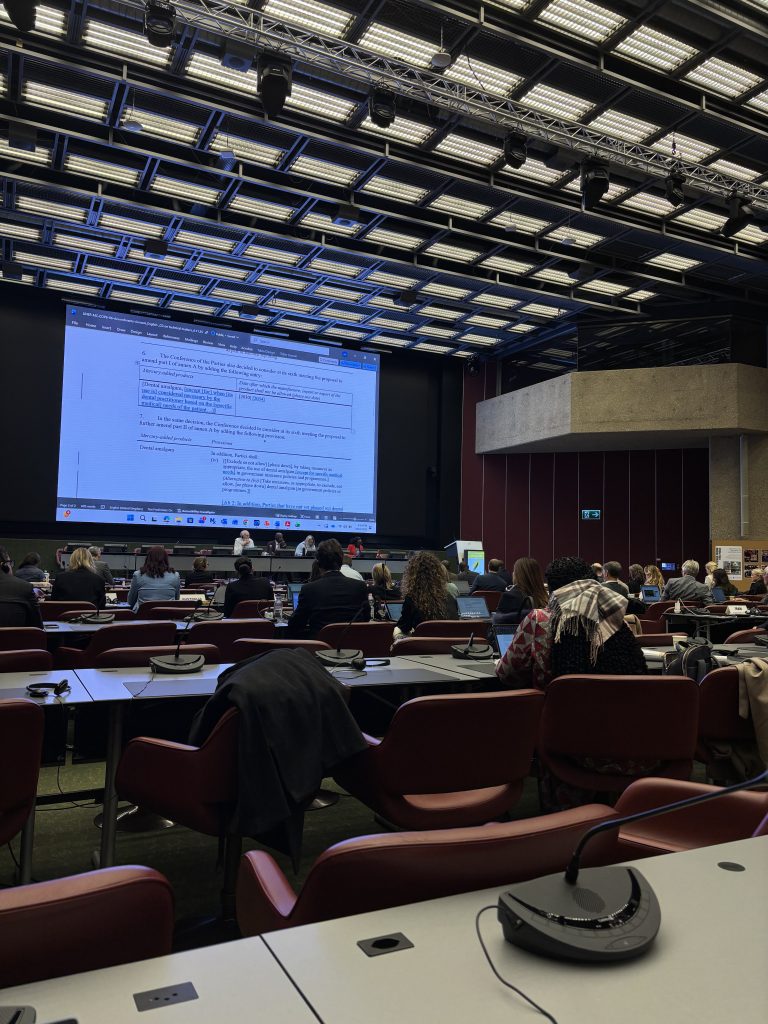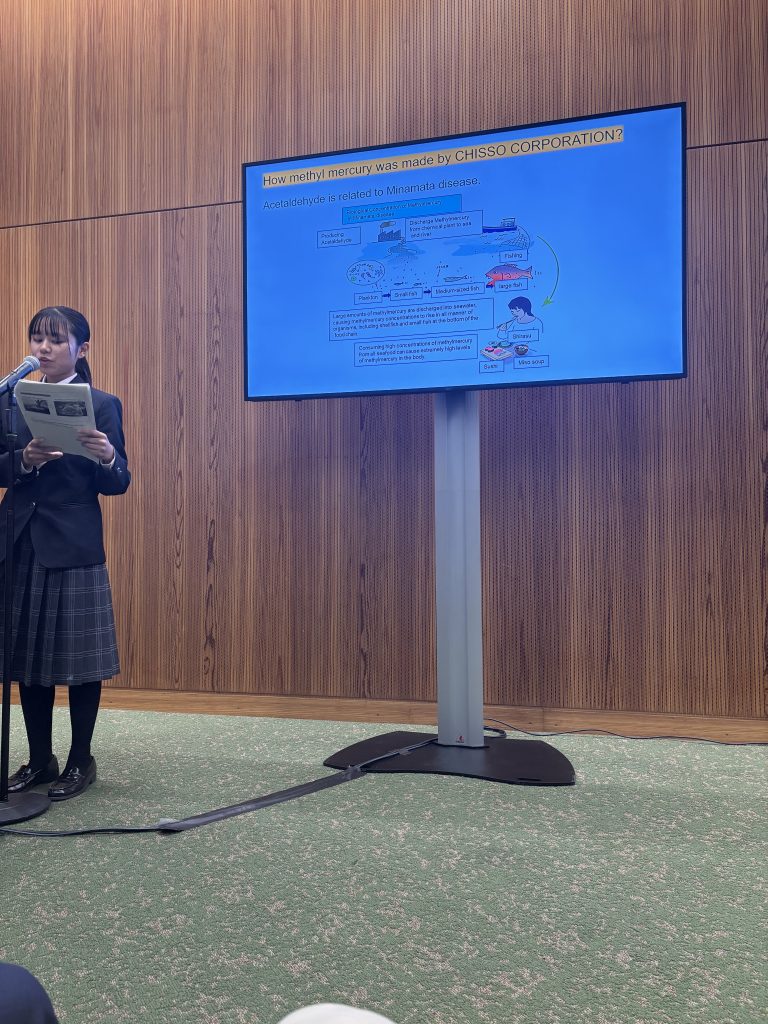Lunch Break:
After the morning Plenary session of the Minamata Convention, our group was starving and eager to explore Geneva’s food scene. I decided to stop at “Pacha Kebab,” where I ordered some type of spicy steak sandwich that turned out to be absolutely delicious. The rest of the group went to “Tasty Chicken Spot,” and after trying some of their leftovers, I can confidently say their food was just as tasty. We enjoyed our meal by the water, soaking in the atmosphere, when we realized we could take a boat ride on Lake Geneva. So, we did just that. We hopped on the boat and had an incredible time cruising across the beautiful lake, surrounded by views of the gorgeous mountains in the distance.


Afternoon Plenary Session:
After our eventful lunch break, we returned to the afternoon Plenary session of the convention, where the main topic of discussion was Artisanal and Small-Scale Gold Mining (ASGM) and its link to mercury pollution. The session was filled with passionate interventions from countries around the world, all emphasizing the urgent need to reduce and eventually eliminate mercury use in gold mining. Brazil opened the discussion with their CRP, and other countries followed, making comments on this as well as the draft decision by the Secretariat.
Colombia opened the discussion by highlighting how mercury pollution has severely affected lakes and rivers, particularly in the Amazon region. Their message was clear: we must protect the Amazon’s ecosystems and the communities that depend on them and work together to eradicate all illegal and mercury-based mining practices. Indonesia supported this sentiment, firmly supporting the removal of mercury from ASGM activities.
Representatives from the European Union noted that mercury use in ASGM continues to rise, with this year seeing the highest levels of mercury emissions to date. They expressed strong support for the Minamata Convention’s goals but also raised some concerns about the draft proposal presented by Brazil. In response, Ecuador voiced their support for implementing Article 7 and showed interest in working collaboratively with Brazil to refine their draft resolution.
Other nations shared their ongoing efforts as well. The Philippines announced they are developing a National Action Plan (NAP) to phase out mercury by 2027, linking this work to the need for tighter mercury trade controls. Pakistan shared that they plan to launch a project by December 2025 aimed at eliminating the socioeconomic risks tied to ASGM. Similarly, Suriname and Mexico both emphasized the deep social and economic impact of small-scale gold mining, noting that complete elimination is complex, but stronger regulation could make a meaningful difference.
Many countries, including Saudi Arabia and the United States, reaffirmed their commitment to a world free from mercury pollution. The U.S. delegation went further, stressing that ASGM is now the largest global source of mercury emissions and warning that profits from illegal mining can finance criminal and terrorist organizations.
Several African nations also took the floor. Zambia and Nigeria discussed their national efforts to implement mercury-free methods, though they acknowledged challenges such as limited technology and funding. Botswana and Uganda reaffirmed their alignment with Africa’s regional position and commitment to the Convention’s goals.
Beyond the national statements, civil society groups also made powerful interventions. The Children and Youth International organization called for more inclusion of young people in decision-making and urged all parties to speed up efforts to remove mercury from ASGM, and did an amazing job in her intervention! The Women’s Caucus asked governments to ensure that gender perspectives are integrated into National Action Plans. Meanwhile, organizations such as Zero Mercury, IPEN, and the Environmental Research Organization all emphasized the global scale of the problem and called for stronger tracking systems for both mercury and gold to close existing loopholes.
The President concluded the session by announcing the establishment of a contact group to continue discussions and refine the proposals.
Overall, this session highlighted how deeply interconnected environmental, social, and economic challenges are within the ASGM issue. I found it inspiring to see so many countries and organizations come together, all aiming for the same goal: a world free of mercury pollution. It reminded me that real change takes cooperation, persistence, and a shared commitment to protect both people and the planet.

Contact Group:
Halfway through the Plenary, we attended a Technical Matters Contact Group meeting that was a continuation from the previous day. The discussion this time centered around the phase out of mercury use in dental amalgam, which turned out to be one of the most passionate and debated topics of the day.
The meeting began with Switzerland adjusting the text to a consolidated version to help guide the discussion. Right away, there were differing opinions. The United States expressed concern that setting strict limits could affect patients who might still need mercury-based dental materials for specific medical reasons. On the other hand, several advocacy groups like Say No to Mercury and the World Alliance for Mercury-Free Dentistry strongly pushed for a complete and immediate end to mercury use in dental products. Say No to Mercury’s message was clear and heartfelt, stating “We cannot continue to poison people for profit.”
A major point of debate revolved around choosing a phase out date, either 2030 or 2034. Ghana spoke passionately in favor of the 2030 date, emphasizing that there is already scientific data showing safe and effective alternatives exist. They argued that the world has had enough time to prepare and that five more years would only delay necessary progress. Bangladesh agreed, noting that countries have already had eight years to act and will still have five more before 2030 arrives.
Other countries, however, urged caution. The United Kingdom, Canada, and the European Union supported keeping the 2034 date, saying that removing it now might be premature. India wasn’t comfortable committing to any date yet, arguing that not all countries have the capacity to transition. The United States said they were personally ready for a 2030 phase-out but understood that some nations may need more time, so they were open to extending it to 2034.
The debate became increasingly intense as groups and countries began huddling together in side discussions to find common ground. It was fascinating to watch the delegates gather in small circles, whispering and negotiating, trying to reach a compromise that everyone could accept.
Saudi Arabia supported the 2030 deadline but agreed that there should be exemptions for specific medical needs. Meanwhile, countries like Brazil argued that there’s no reason to wait because alternatives to mercury amalgam are already available, and the longer we delay, the more damage is done to people and the environment.
In the end, the discussion didn’t reach a final decision, but it showed just how complex global policymaking can be. Although, after the UK, US, Ghana, and other countries huddled together, there seemed to be some progress and cooperation made due to the UK’s strong stance on not being ready for the 2030 deadline. Even when everyone agrees on the goal, to eliminate mercury, there are still tough questions about how fast and under what conditions that transition should happen.
For me, it was one of the most interesting sessions to observe. Seeing the mix of science, policy, and human emotion play out in real time gave me a deeper appreciation for how much work and collaboration go into these international agreements. The process isn’t easy, but it’s encouraging to see so many voices from around the world working toward a safer, mercury free future.

Knowledge Lab:
Once the contact group concluded, we wrapped up the day with a wonderful Knowledge Lab presentation by two Japanese high school students titled “Learning from the Past Experience and into the Future: from Minamata High School.” They shared their perspectives on studying the history of Minamata and the Minamata disease while growing up in the very place where it all happened. Their presentation was very insightful, and they handled questions from the audience with confidence. I was especially impressed by their ability to present in front of such a large international crowd and smoothly toggle between English and Japanese throughout their talk.

Looking Ahead:
I’m really looking forward to Day 3 of the Minamata Convention, excited to see what new discussions, ideas, and experiences await as we continue learning about global efforts to protect people and the planet from mercury pollution!
Best,
Ryan Sundheimer